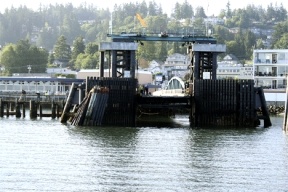The investigation into Friday’s ferry crash will take two weeks or so to complete, a state ferry spokeswoman said this week.
The ferry M/V Cathlamet ran into the ferry terminal in Mukilteo at high speed last week and damaged a large group of pilings, called a dolphin.
The impact of the landing, which occurred just before 6 a.m., caused the dolphin to collapse, blocking the entrance to the slip.
“It was like pick-up sticks,” said ferry spokeswoman Susan Harris-Huether describing how pulling out the debris only led to more collapses. A tug boat was on the scene later in the day to clear the dolphin out of the way and service resumed.
The wheel house crew was drug tested, a routine measure in cases such as the crash, Harris-Huether said. The captain of the M/V Cathlamet was been placed on paid leave.
She declined to comment on what the crew and the captain of the Cathlamet said about the crash until the investigation is completed.
“Someone’s career is at stake here,” she said.
The cause of the accident is still unknown. Washington State Ferries is conducting an investigation with the help of the Coast Guard and the Washington State Patrol.
“It’ll take about two weeks,” Harris-Huether said. “They have to interview a lot of eyewitnesses and crew. They’ll review tapes and recordings. I don’t expect to hear anything for about two weeks.”
After the ferry crashed, it stranded commuters for hours in Clinton and Mukilteo. By late afternoon, regular crossings every 30 minutes had been restored for Clinton and Mukilteo passengers.
However, because the M/V Cathlamet was out of commission for repairs, ferries from other routes were shifted due to the Mukilteo accident, which led to delays and grumpy drivers elsewhere.
Several vessels are being rerouted within the ferry system to replace the damaged ferry.
Ferries from the San Juan Islands, Port Townsend/Keystone and from the Port Townsend/San Juan routes were sent to Clinton to fill in for the Cathlamet.
The Clinton/Mukilteo run is a high priority crossing and one of the state’s busiest. The route carried more than 4 million riders in 2005 and more than 2.2 million vehicles.
“It’s not the impact on the route, but it’s the impact on the number of people,” Harris-Huether said.
The top three routes in Washington, which include the Mukilteo/Clinton run, transport 62 percent of all passengers in the ferry system.
How long it will take to repair the Cathlamet is unclear. Harris-Huether said it was too early to tell if the damage to the ship was only cosmetic or structural.
The cost of the accident is also unclear at this point.
The Cathlamet has seen rough sailing before.
In September 1986, the propulsion system of the ferry malfunctioned and the boat crashed into the dock in Clinton, causing at least $500,000 damage. However, the damage to the dock was much more substantial.



